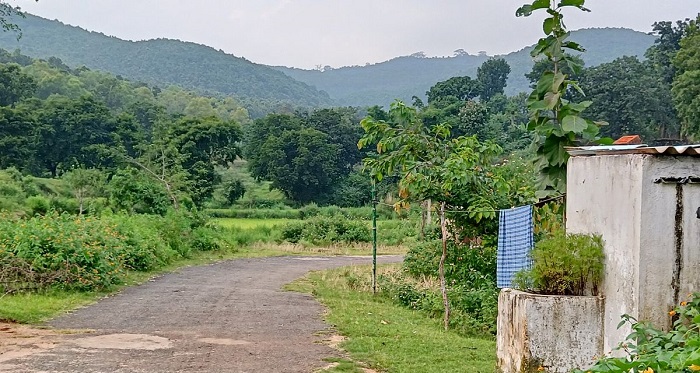
Ranchi: For the people of Jharkhand state, an Indian state in eastern parts of India, trees are their lifeline. Worshipping trees is their biggest prayer. No festival is more important to them than that of karma pooja and sarhul, held annually.
Karma is a tree that tribal people consider as the most sacred grown on the earth. On the day of karma pooja during August-September every year, three branches, the one who has given birth, the one who protects, and the one who is the caretaker, are cut from the trees and planted at a place of worship.
Historically, tribal people had escaped attacks from invaders about 500 years ago by hiding in their forests. Sarhul celebrations last for three days during which the tribal communities pray for a good harvest by worshipping sal trees in their sacred groves.
They also remember their forefathers on these occasions. “Our ancestors used the leaves of sal trees for clothing and its fruits for food. Even after keeping in water, its leaves do not rot. No other tree has this special quality. A local tribal leader says sal is very resilient.
Beating of drums, singing and dancing to the tune of folk songs are all part of the folklore. A cultural dance named jadur is the main attraction as it is performed only during sarhul, symbolising respect for forest lands. Both men and women from Uraanv and Munda tribes participate in the dance.
The priest conducts the ceremony by keeping three pots filled with water at the sarna on the first day. On the third day, if the water in the pot is found to have reduced, it is considered as a sign of fluctuations in rainfall that year. If the water level remains the same, it is concluded that the year will see good rainfall.
On the last day of sarhul, the priest hands over sal flowers to all families in the village or tuck them on their house doors to welcome prosperity and growth. Sal trees mostly constitute the forest of Jharkhand region. "Worshipping an idol does not give us anything, neither water nor oxygen but the tree we worship provides us with everything," said a tribal leader.
As per the2011 census, of the 3.3 crore people in Jharkhand, 86.3 lakh are tribal people belonging to Sarna, Christianity, Hinduism and Islam. But irrespective of their religious backgrounds, they give priority to water, forest and land. For them, nature is the first priority. “We get medicine, fruits and flowers from trees. We feed sal leaves to our goats and sell them in the local market once they are fully grown. This is our source of livelihood,” says an elected panchayat head of a village in Jharkhand state.
“The village did not see a single case ofCOVID-19. People here rarely fall ill due to the pleasant and cool environment. In fact, even during peak summer, we use a thick blanket while sleeping,” he added.
Traditional conservation knowledge is passed down through generations. “Children in village school are taught indigenous techniques in farming, forest, water and land conservation. We also take them to the weekly village panchayat has to keep them connected to our culture and nature,” said a local village head. People in Ormanjhi block of Jharkhand state have groups of men and women guarding the forest in shifts starting from 6 am to 10 am and 2 pm to 6 pm.
Their daily activities in the forest, spread across 400 acres, are decided at the weekly village panchayat meetings. Every group has 10 to 12 people.
"There is no interference from the forest department," says the village head. A villager says that people have promoted conservation since 1992. But it got a new direction in 2005, when a forest conservation committee was formed to preserve water, forest and land. In 2016, the forest department awarded them a grant of Rs 4 lakh, which was utilised to create water harvesting structures.
"Though the department trains new recruits, we also pitch in by sharing our traditional conservation methods and knowledge on how to save forests from fires, harvest rainwater and build loose boulder structures using desi methods," informs the village head.
The conservation efforts have transformed the image of the place in such a way that Prime Minister Narendra Modi himself had discussed this change in his weekly 'Mann Ki Baat' radio address. The village panchayat’s decisions to ban tree felling in the forest since 2015 and drilling of individual borewells in houses since 2017 were the turning points in conservation efforts.
Until then, they could not save as many trees as they wanted because it was difficult to govern the felling of trees. Under the new system, village panchayat has to be approached in case a villager needs timber, which is permitted only when it is an utmost necessity.
The villagers also took up rainwater harvesting in 2019 to prevent runoffs from a nearby hill. “Earlier, rainwater used to go to waste. But after we dammed the water and diverted its flow into our fields and ponds, we are enjoying the benefits of a water surplus,” said villagers .
The villagers are reaping the fruits of their labour today. “We are blessed with good rains now. Thanks to forest conservation, apricot, pithore, mango, java plum, bahra (plum), bel are plentiful. If there is no forest, there will be no village,” say the villagers. The forest has 500 species of trees and plants. Monkeys no longer stray in and ruin crops as they have enough to eat in the forest.